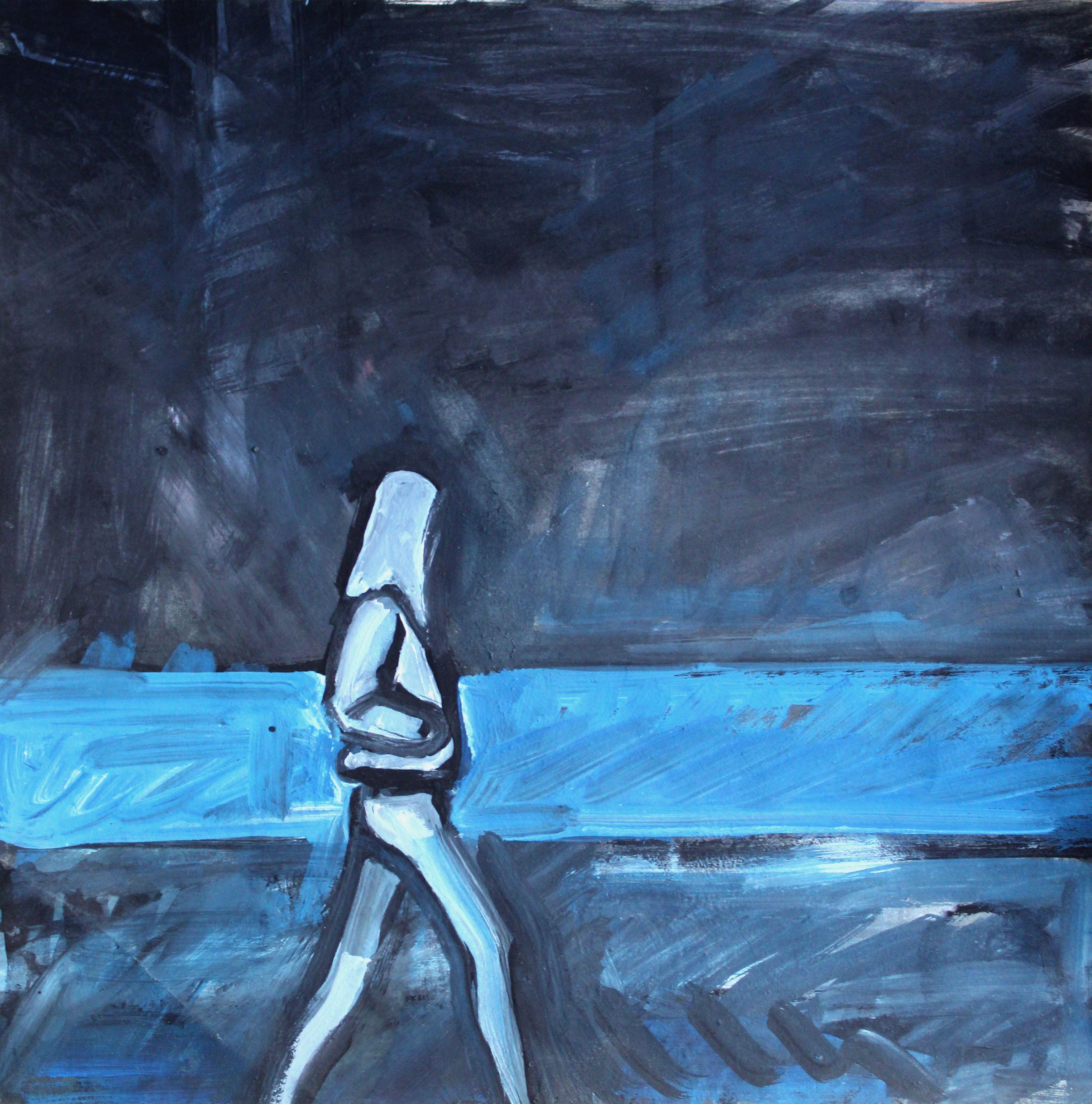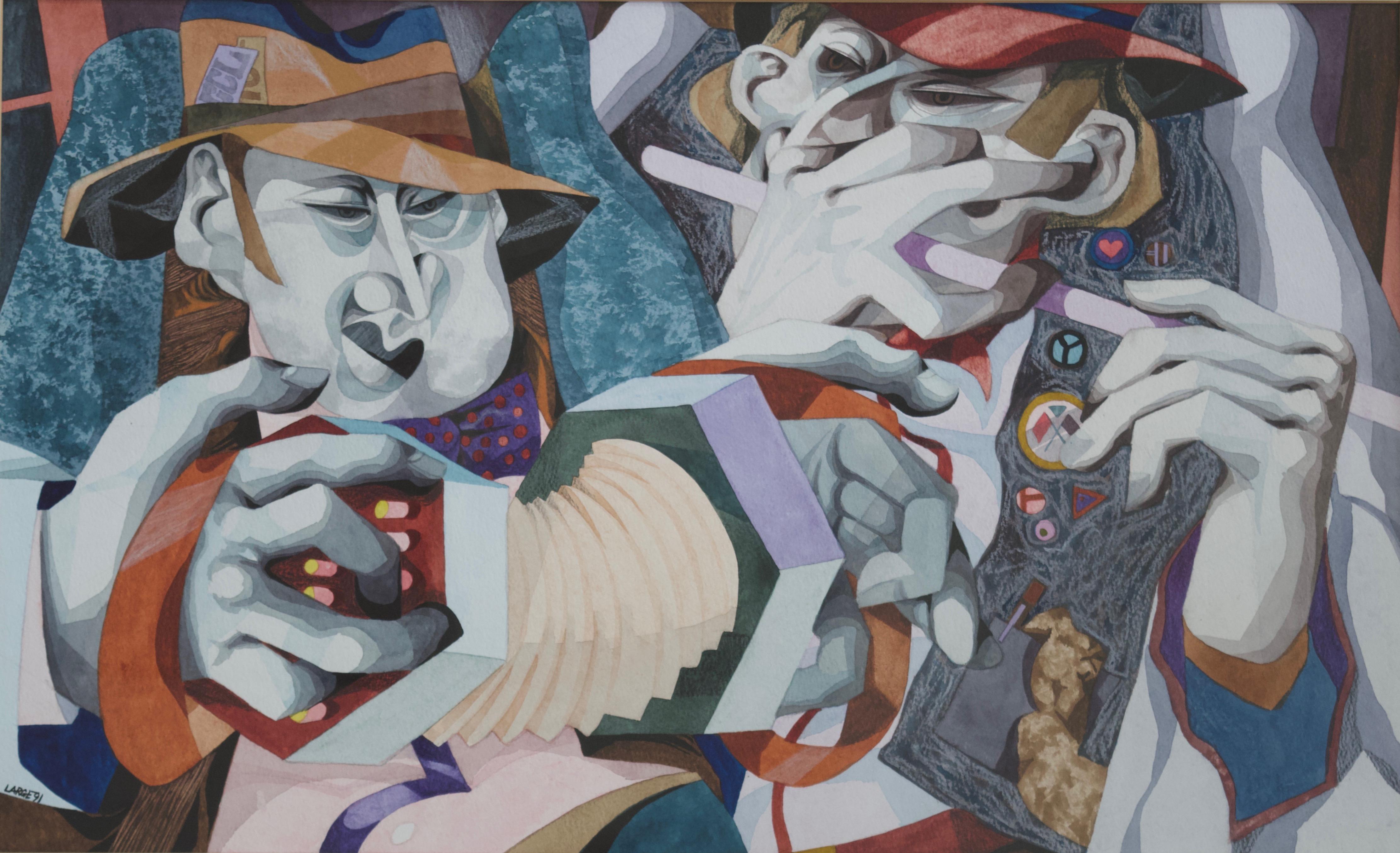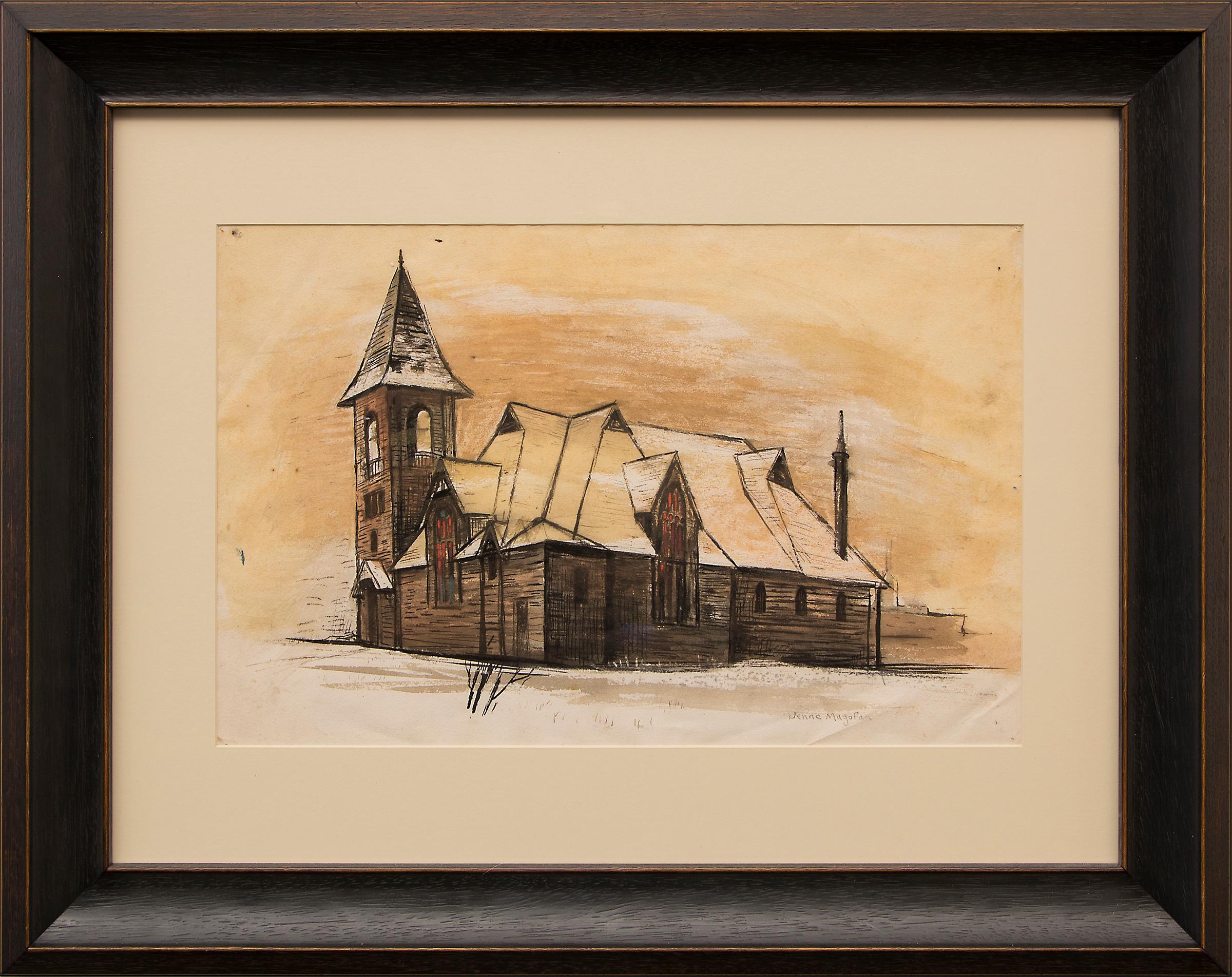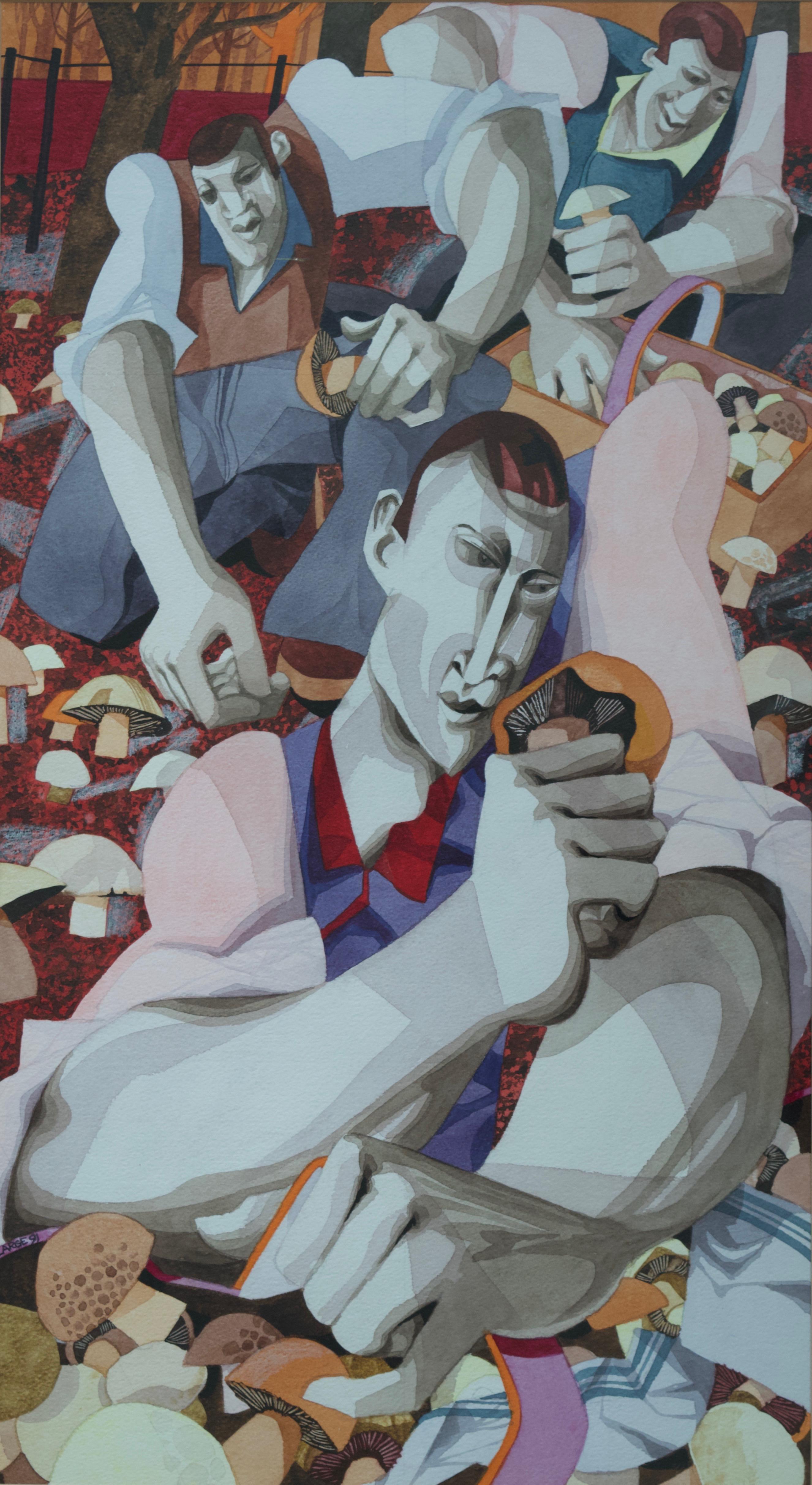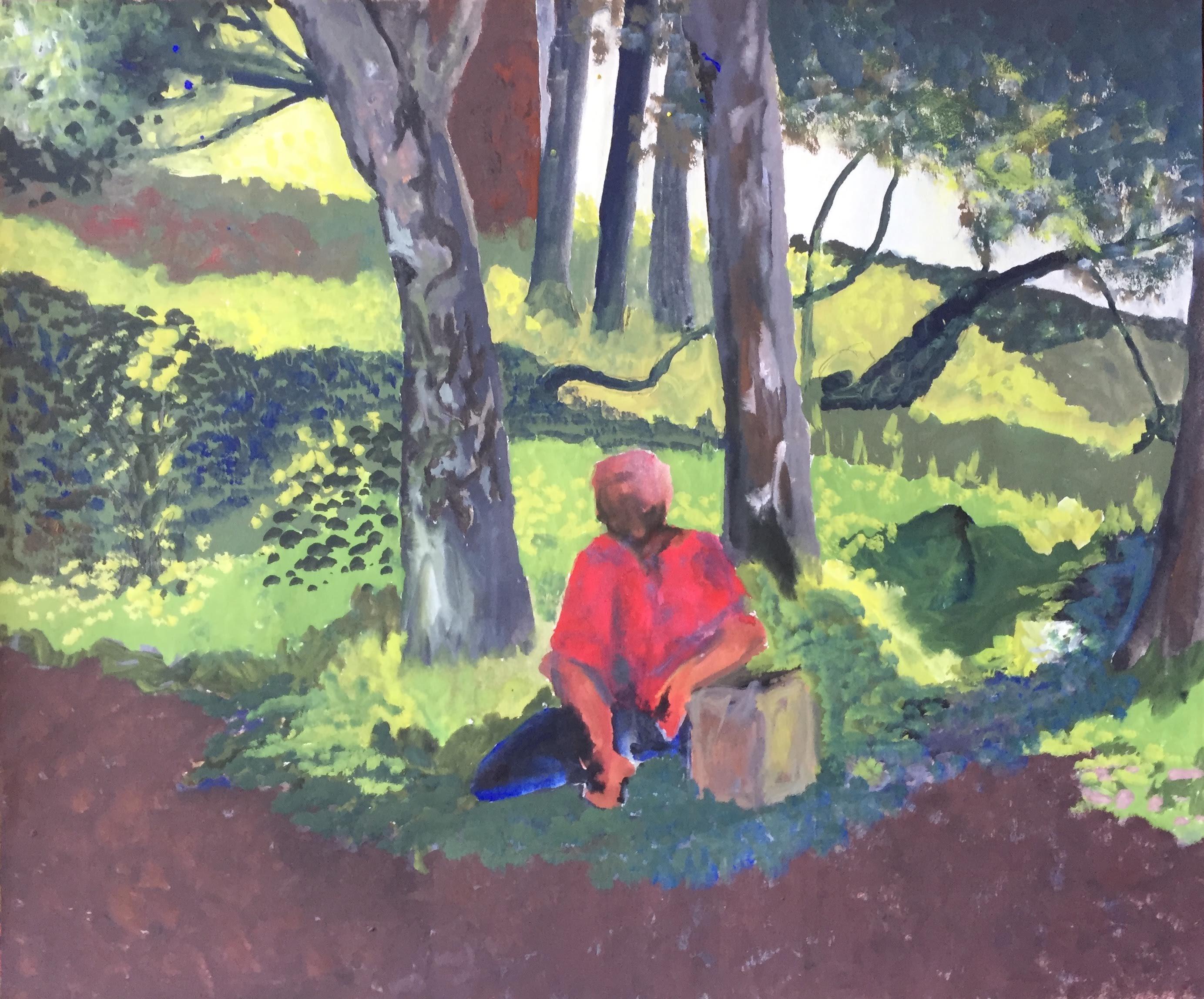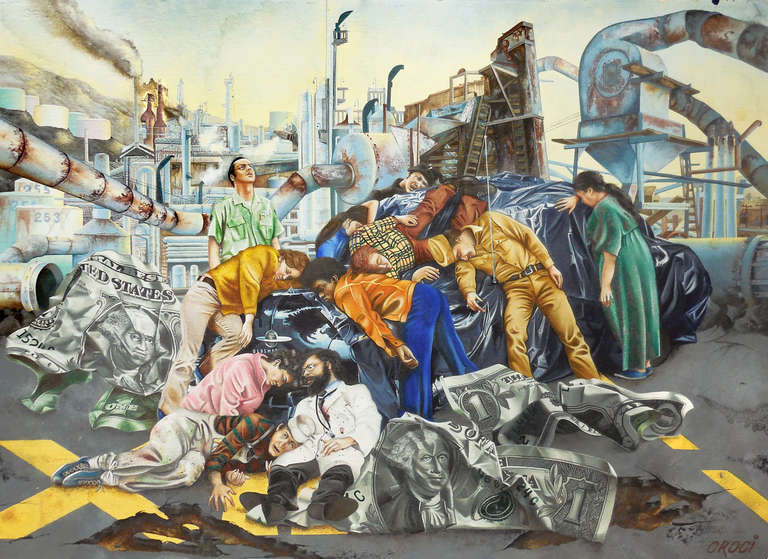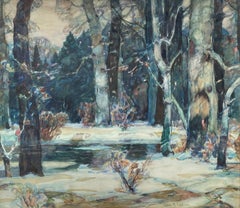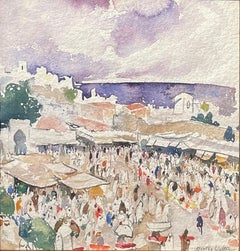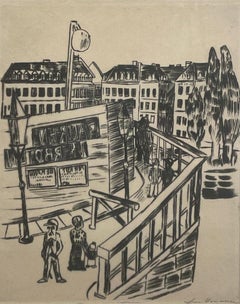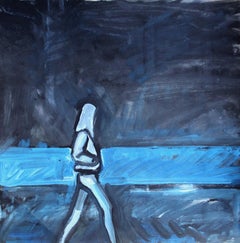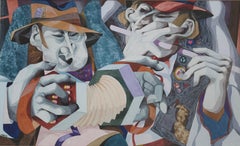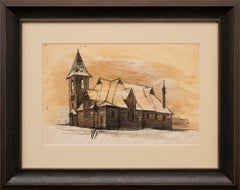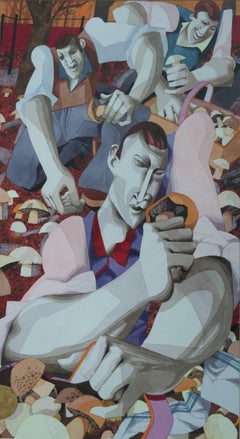Items Similar to "China Town" Ernest Fiene, 1925 Modernist Watercolor on Paper Chinatown Scene
Want more images or videos?
Request additional images or videos from the seller
1 of 7
Ernest Fiene"China Town" Ernest Fiene, 1925 Modernist Watercolor on Paper Chinatown Scene1925
1925
About the Item
Ernest Fiene
China Town, 1925
Signed and dated to lower right ‘Ernest Fiene 1925’.
Watercolor on paper
18 1/2 x 14 5/8 inches
Ernest Fiene was born in Elberfeld, Germany in 1894. As a teenager, Fiene immigrated to the United States in 1912. He studied art at the National Academy of Design in New York City from 1914 to 1918, taking day classes with Thomas Maynard and evening classes with Leon Kroll. Fiene continued his studies at the Beaux-Arts Institute of Design in New York from 1916 to 1918, adding classes in printmaking at the Art Students League in 1923.
Fiene began his career as an artist in 1919 with his first exhibition of watercolors at the MacDowell Club arranged by his mentor Robert Henri. In 1923 the Whitney Studio Club mounted a large exhibition of his works. The following year he had an exhibition at the New Gallery in New York, which completely sold out all fifty-two works, including paintings, watercolors, drawings, and etchings. With the proceeds of sales from the New Gallery exhibition, Ernest Fiene and his younger brother Paul, a sculptor, built studios in Woodstock, New York in 1925.
In the early Twenties Ernest Fiene painted mostly landscapes of Woodstock and both the Ramapo and Hudson River Valleys. The first monograph from the Younger Artists Series was published on Fiene in 1922. Published in Woodstock, the series went on to include Alexander Brook, Peggy Bacon, and Yasuo Kuniyoshi. The book reproduced 1 illustration in color and another 27 reproductions in black and white. Around 1925 Fiene became fascinated with the intensity, excitement, and opportunities for color harmonies New York City offered as a subject. His paintings shifted to urban and industrial themes with architecture, industry, and transportation becoming his subjects.
By 1926 Fiene had attracted the dealer Frank K.M. Rehn, who gave him a one-man exhibition that year, which travelled to the Boston Arts Club. C.W. Kraushaar Galleries gave Fiene a one-man exhibition of urban, landscape, portrait, and still life paintings in 1927. Julianna Force, the director of the Whitney Studio Club and first director of the Whitney Museum of American Art, included two of Fiene’s paintings in a fall exhibition in 1928. The Whitney Studio Club showed Fiene’s paintings in a two-man exhibition with Glenn O. Coleman that year and acquired three of Fiene’s paintings. Also in 1928 Fiene became affiliated with Edith Halpert’s Downtown Gallery where he had an exhibition of 20 lithographs in the spring. Fiene sold his house in Woodstock in 1928 to spend more of his time in New York City.
With so many successful exhibitions, Fiene returned to Paris in 1928-29 where he rented Jules Pascin's studio and studied at the Académie de la Grande Chaumière. In France, Fiene painted both landscape and urban subjects developed from ideas influenced by Cubist geometry and the use of flat areas of broad color. Upon returning to New York in 1930, Fiene used this new approach to continue to paint New York skyscraper and waterfront subjects, as well as to begin a series of paintings on changing old New York based on the excavations for Radio City Music Hall and the construction of the Empire State Building. Frank K.M. Rehn Galleries exhibited this series, titled “Changing Old New York,” in 1931. Fiene also has solo exhibitions at Rehn Galleries in 1930 and 1932. Fiene’s oil paintings are exhibited at the Chicago Arts Club in 1930 as well.
Fiene was included in the Museum of Modern Art’s exhibition Painting and Sculpture by Living Americans in December of 1931. Visiting New York, Henri Matisse saw the exhibition and called Fiene’s Razing Buildings, West 49th Street the finest painting he had seen in New York. Fiene had two mural studies from his Mechanical Progress series exhibited at the Museum of Modern Art’s exhibition Murals by American Painters and Photographers in 1932. Fiene sent View from my Window which depicts Fiene working on a lithograph stone while looking out his window to the newly completed Empire State Building to the Carnegie International in 1931. In 1932 Fiene participated in the first Biennial of American Painting at the Whitney Museum and his prints were included in exhibitions at the Downtown Gallery and the Wehye Gallery. In the same year, Fiene was awarded a Guggenheim fellowship to further study mural painting in Florence, Italy.
On his return from Italy in 1933 Fiene re-engaged himself in New York City life and won several public and private mural projects. Fiene resumed his active exhibition schedule, participating in two group exhibitions at the Whitney Museum and a one-man exhibition of recent paintings at the Downtown Gallery in January 1934. In 1933 he purchased a farm in Southbury, Connecticut, which added Connecticut scenes to his landscape subjects. This was also the year Fiene began to spend summers on Monhegan Island, Maine, where he painted seascapes, harbor scenes, and still lifes.
Fiene’s landscape paintings attracted numerous commissions as part of the American Scene movement. Through the fall and winter of 1935-36, Fiene took an extended sketching trip through the urban, industrial, and farming areas of Pennsylvania and West Virginia. Most of the twenty-four Pennsylvania urban and rural paintings from this trip were featured in an exhibition held at the First National Bank in Pittsburgh in October of 1937 by the Pittsburgh Commission for Industrial Expansion. Fiene said of these works that he formed rhythm, opportunity for space and color, and integrity in the Pennsylvania mill and furnace paintings. Fiene received the silver medal for one of the Pittsburgh paintings titled Frosty Morning at the Art Institute of Chicago in 1937.
The Colorado Springs Fine Arts Center invited Fiene to spend the summer of 1935 teaching there. He accepted and fit in painting trips through Colorado and New Mexico, including Taos and Santa Fe. In 1935, the Arts Center had an exhibition of his oils and watercolors. In August of that year the Denver Art Museum has an exhibition of thirty paintings and watercolors and purchased the painting Connecticut Hills, Winter. The Denver Art Museum held an exhibition of Fiene’s lithographs in 1937.
In 1937 Fiene also completed a mural for the Post Office in Canton, Massachusetts. In 1938 he completed a large four panel mural for the Department of the Interior Building in Washington, DC. Fiene's largest mural project was for the High School of Needle Trades, begun in 1937 and unveiled in 1940 after two and a half years of constant work.
Fiene had his largest exhibitions in 1940 with a total of 53 paintings and watercolors at his new dealer Associated American Artists. The exhibition includes Razing the Old Post Office, a New York subject which received a prize at the Carnegie International in 1939; Frosty Morning which received silver medal at the Art Institute of Chicago in 1937, and Spring Evening which received the W.A. Clark prize from the Corcoran Gallery in 1939.
Ernest Fiene participated in the American Tobacco Company’s series of tobacco paintings, commissioned from 1940 to 1942 by the company’s president George Washington Hill. American Tobacco sought the best artists of the time, including Ernest Fiene, Aaron Bohrod, Thomas Hart Benton, Doris Lee, George Schreiber and Frederick Taubes, to depict the entire tobacco production, from planting and harvesting to curing and auction. The paintings, which continued to arrive at American Tobacco until 1945, were used to decorate the company’s headquarters and in advertisements. American Tobacco described the commission as “a series of paintings of the tobacco country by America’s foremost artists.”
During the war years, much of Fiene’s commission work consisted of painting various phases of industry in relation to the war, such as the trips he took to Texas and Louisiana to record the operations of the oil industry. He also recorded the making of optical instruments at Abbott Laboratories in Corning, New York. These war industry paintings were exhibited in 1944 at the Associated American Artists gallery in New York City.
As a successful artist Fiene was in demand as a teacher. Fiene taught at Westchester County Center in New York from 1930 to 1931 and at the Cooper Union in New York from 1938 to 1939. At the Art Students League he taught a well-known Saturday class from 1939 until his death in 1965. Fiene also taught at the National Academy of Design from 1959 to 1964; he was elected an Academician there in 1952.
Fiene’s dealer during the 1950s and 1960s was Midtown Galleries in New York. In 1959 Midtown gave Fiene a solo exhibition of his most recent, more abstracted New York City subjects, which received glowing reviews. Fiene enjoyed widespread respect among the community of artists in America. Elected president of the Artists Equity Association in 1953, Fiene remained that organization’s president in an honorary capacity until his death in 1965.
He maintained a long time personal correspondence with the artists George Grosz, Jules Pascin, Gaston Lachaise, Stuart Davis, and Thomas Hart Benton.
Ernest Fiene’s work is included in numerous public collections, including the Brooklyn Museum; Art Institute of Chicago; Cleveland Museum of Art; Denver Art Museum; Los Angeles County Museum of Art; Museum of Fine Arts, Boston; Pennsylvania Academy of the Fine Arts; and the Whitney Museum of American Art.
- Creator:Ernest Fiene (1894-1965, American)
- Creation Year:1925
- Dimensions:Height: 23 in (58.42 cm)Width: 19 in (48.26 cm)
- More Editions & Sizes:Unique WorkPrice: $3,000
- Medium:
- Movement & Style:
- Period:
- Condition:
- Gallery Location:New York, NY
- Reference Number:1stDibs: LU1841215410242
About the Seller
5.0
Gold Seller
Premium sellers maintaining a 4.3+ rating and 24-hour response times
Established in 2022
1stDibs seller since 2022
98 sales on 1stDibs
Typical response time: <1 hour
- ShippingRetrieving quote...Shipping from: New York, NY
- Return Policy
Authenticity Guarantee
In the unlikely event there’s an issue with an item’s authenticity, contact us within 1 year for a full refund. DetailsMoney-Back Guarantee
If your item is not as described, is damaged in transit, or does not arrive, contact us within 7 days for a full refund. Details24-Hour Cancellation
You have a 24-hour grace period in which to reconsider your purchase, with no questions asked.Vetted Professional Sellers
Our world-class sellers must adhere to strict standards for service and quality, maintaining the integrity of our listings.Price-Match Guarantee
If you find that a seller listed the same item for a lower price elsewhere, we’ll match it.Trusted Global Delivery
Our best-in-class carrier network provides specialized shipping options worldwide, including custom delivery.More From This Seller
View All"Forest Landscape" John F. Carlson, circa 1925 American Impressionist Landscape
By John F. Carlson
Located in New York, NY
John F. Carlson
Forest Landscape, circa 1925
Signed lower right
Watercolor on paper
Sight 21 x 24 1/2 inches
The native Sweden John Fabian Carlson became a household name in New Yo...
Category
1920s American Impressionist Landscape Paintings
Materials
Paper, Watercolor
"Market Scene, North Africa" Martha Walter, Female Impressionist Scene of Market
By Martha Walter
Located in New York, NY
Martha Walter
Market Scene, North Africa
Signed lower right
Watercolor on paper
9 x 9 inches
Martha Walter was best known as a painter of colorful beach scenes and landscapes. Infl...
Category
Early 20th Century Impressionist Figurative Paintings
Materials
Paper, Watercolor
"Corbett House, Monhegan Island, Maine" Jamie Wyeth, 1973 Maine Watercolor
By Jamie Wyeth
Located in New York, NY
Jamie Wyeth
Corbett House, Monhegan Island, Maine, 1973
Signed lower left
Watercolor on paper
20 3/4 x 28 1/2 inches
The house depicted in the present work is on Monhegan Island, Ma...
Category
1970s Realist Figurative Paintings
Materials
Paper, Watercolor
"Holzbrücke" Max Beckmann, 1922 Modernist Drypoint Urban Landscape
By Max Beckmann
Located in New York, NY
Max Beckmann
Holzbrücke, 1922
Signed in pencil lower right
Drypoint on cream wove paper
11 3/8 x 9 3/8 inches
From the edition of 150
Max Beckmann dreamed up a world of actors, cab...
Category
1920s Modern Figurative Paintings
Materials
Handmade Paper, Drypoint
"Winter Landscape" William Lester Stevens, Cape Ann Snowy Landscape
By William Lester Stevens
Located in New York, NY
William Lester Stevens
Winter Landscape
Signed lower right
Oil on canvas
32 x 36 inches
Born on June 15, 1888, in Rockport, Massachusetts, Stevens displayed his artistic abilities ...
Category
1920s Modern Figurative Paintings
Materials
Canvas, Oil
"Spring Ploughing" Georgina Klitgaard, Modernist American Farmed Landscape
By Georgina Klitgaard
Located in New York, NY
Georgina Klitgaard
Spring Ploughing
Signed lower right
Oil on canvas
34 x 42 inches
Georgina Klitgaard’s art has sometimes gotten lost in the critical propensity to assign artists ...
Category
1940s American Modern Landscape Paintings
Materials
Canvas, Oil
You May Also Like
Walking along the sea. 2024, gouache, paper, 25x25 cm
Located in Riga, LV
Walking along the sea. 2024, gouache, paper, 25x25 cm
Ansis Butnors (1977)
Education:
J. Rozentals Art School in Riga – 1989. – 1996.
Latvian Academy of Art, Painting Department –...
Category
2010s Modern Figurative Paintings
Materials
Paper, Gouache
George Large, Street Musicians, Cubist art
By George Large
Located in Harkstead, GB
***Please note the glass will be removed for shipping***
For local and London deliveries the glass can be retained if agreed prior to purchase.
George Large, R.I. (born 1936)
Street musicians
Signed and dated (19)91
Watercolour over traces of pencil
15¾ x 26
25½ x 35 with frame
George Large is a painter in watercolour and oil, born in Islington, London in 1936. He studied at Hornsey College of Art (1958-63), teachers including Maurice de Sausmarez, John Titchell and Alfred Daniels. Large spent some time in the display department of Simpson’s, Piccadilly, was part-time at Hornsey College of Art, then head of department at St Julian...
Category
Late 20th Century Modern Figurative Paintings
Materials
Paper, Watercolor, Pencil
Church in Leadville, Colorado, 1930s Framed Landscape Watercolor & Ink Painting
By Jenne Magafan
Located in Denver, CO
This rare, original WPA-era painting, Church in Leadville (1938), was created by renowned Colorado and Woodstock modernist artist Jenne Magafan (1916-1952). The watercolor and ink wo...
Category
1930s American Modern Landscape Paintings
Materials
Archival Ink, Archival Paper, Watercolor
George Large, The Fungi Collectors, Cubist art
By George Large
Located in Harkstead, GB
***Please note the glass will be removed for shipping***
For local and London deliveries the glass can be retained if agreed prior to purchase.
George Large, R.I. (born 1936)
Edible Fungi
Signed and dated (19)91
Watercolour over traces of pencil
26¾ x 14¾
37 x 24½ with frame
George Large is a painter in watercolour and oil, born in Islington, London in 1936. He studied at Hornsey College of Art (1958-63), teachers including Maurice de Sausmarez, John Titchell and Alfred Daniels. Large spent some time in the display department of Simpson’s, Piccadilly, was part-time at Hornsey College of Art, then head of department at St Julian...
Category
Late 20th Century Modern Figurative Paintings
Materials
Paper, Watercolor, Pencil
Mid Century Landscape Figure Painting Art Institute of SF Green, Red, Blue
By Gloria Dudfield
Located in Arp, TX
Gloria Dudfield (1922-2015)
Untitled
c.1960s
Gouache on paper
18"x15" unframed
Unsigned
Came from a portfolio of her work in the San Francisco Bay Area.
Gloria had a Master of Arts...
Category
Mid-20th Century Modern Figurative Paintings
Materials
Paper, Gouache
'Any Day in America', Social Realist, Beat Generation, Allen Ginsberg
By Ron Croci
Located in Santa Cruz, CA
Signed lower right, "Croci" for Ron Croci (American, born 1945), and painted circa 1970.
A substantial, Social Realist watercolor showing a view of a ramshackle rust-belt landscape ...
Category
1970s American Modern Figurative Paintings
Materials
Watercolor, Handmade Paper
$3,575 Sale Price
35% Off
Recently Viewed
View AllMore Ways To Browse
Antique Paper Company
Antique Post Office
Antique Reproduction Paintings
Chinese Antique Signed Painting
Chinese Medal
Beaux Art Murals
Antique Italian China
Pennsylvania China
Warring States Chinese
Old Radio
Framed German Book Illustration
German Portrait Painting 1920
Paris Street Scene Lithograph
Antique Music Book
1920 Post Office
French Street Scene 1950s
Thomas Alexander
Man O War
